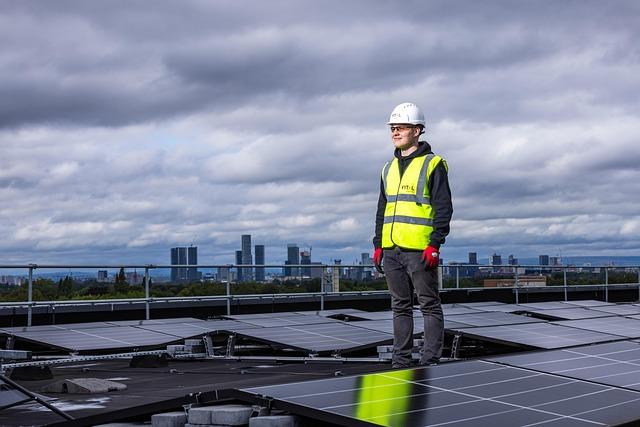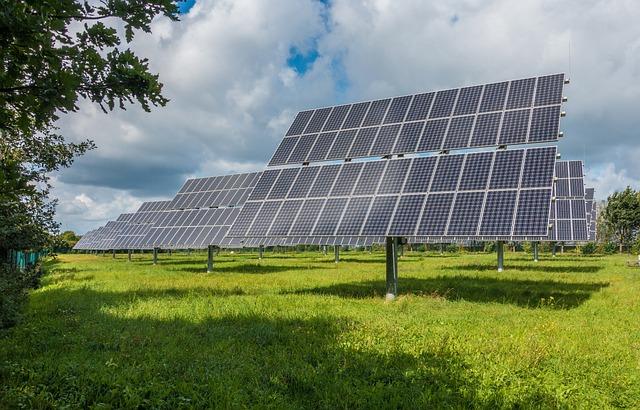Egypt has emerged as a beacon of progress in Africa’s renewable energy landscape, recently securing its position as the continent’s second-largest producer of solar energy, according to the State Information Service (SIS).This noteworthy achievement underscores the nation’s commitment to harnessing its abundant sunlight and advancing its sustainable energy initiatives.As countries around the globe seek to transition to cleaner energy solutions, Egypt stands at the forefront of this movement in Africa, leveraging its strategic investments and innovative projects in solar technology. This article delves into the factors contributing to Egypt’s rapid growth in solar energy production, the impact on the country’s economy, and its potential to lead the way in the renewable energy sector across the continent.
Egypt’s Emergence as africa’s Solar Energy Powerhouse
In recent years, Egypt has positioned itself as a leader in solar energy production, leveraging its abundant natural resources and favorable geographical conditions. With vast stretches of desert that receive ample sunlight throughout the year, the nation has tapped into this potential to establish a robust solar energy infrastructure. Key projects, such as the Benban Solar Park, have played a crucial role, boasting an impressive capacity of over 1.8 gigawatts and serving as a testament to Egypt’s commitment to renewable energy. This park alone is designed to contribute significantly to the country’s energy needs while reducing reliance on fossil fuels.
The government’s vision to reduce carbon emissions and promote sustainable progress has further accelerated investments in solar technology. Several initiatives have been launched to attract local and foreign investors, encouraging the construction of solar farms across the country. The socio-economic impact of these advancements includes:
- Job Creation: Thousands of jobs in construction and renewable energy sectors.
- Energy Security: Diversifying energy sources to ensure reliability and sustainability.
- Export Opportunities: Positioning Egypt as a potential energy exporter in the region.
As Egypt continues to innovate and expand its solar capabilities, the potential for growth in this sector remains important. The nation is well on its way to becoming not just a regional leader, but a global player in the renewable energy landscape.

Investment trends and Market Potential in Egypt’s Solar Sector
Egypt’s solar sector has been gaining momentum, positioning the country as a pivotal player in Africa’s renewable energy landscape. Several factors are driving this surge, including favorable climatic conditions, government incentives, and international partnerships aimed at boosting solar infrastructure. The government has set enterprising targets to increase the share of renewable energy in the overall energy mix, aiming for 20% by 2022 and 42% by 2035. This commitment is indicative of the long-term vision to harness Egypt’s abundant sunlight, with solar projects proliferating across the nation.
Investment trends reflect a growing confidence among both local and international stakeholders. Significant investments have poured into solar energy projects, with financing from various sources, including multilateral development banks and private sector partnerships. Key aspects shaping the market potential include:
- Strategic partnerships: Collaborations between government entities and private firms.
- Technological advancement: Implementation of cutting-edge solar technologies to increase efficiency.
- Infrastructure development: Upgrades to grid systems facilitating solar energy integration.
The following table outlines some of the prominent solar projects in Egypt, illustrating their scale and impact:
| Project name | Capacity (MW) | Location | Status |
|---|---|---|---|
| Benban Solar Park | 1650 | Aswan | Operational |
| Kom Ombo PV project | 200 | Aswan | under Construction |
| Gabal El-Zeit Wind Farm | 580 | Red Sea | Operational |

Technological Innovations Driving Solar Energy Production in Egypt
In recent years, Egypt has witnessed remarkable progress in solar energy production, majorly propelled by cutting-edge technological innovations. Among these advancements, photovoltaic (PV) technology has emerged as a game changer, enhancing the efficiency and reliability of solar panels. Innovations such as bifacial solar panels, which harness sunlight from both sides, and thin-film solar cells, known for their adaptability and lightweight properties, are becoming increasingly prevalent. Additionally, the integration of smart grid technology allows for real-time monitoring and management of energy distribution, optimizing solar output and reducing wastage.
Moreover, Egypt has invested heavily in large-scale solar projects, such as the renowned Benban Solar Park, which has significantly contributed to the country’s energy capacity. The park showcases the potential of concentrated solar power (CSP) systems that use mirrors to focus sunlight to generate heat, managing energy production even under varying weather conditions. As a result, renewable energy storage solutions are also evolving, with innovations like lithium-ion batteries and flow batteries providing efficient ways to store solar energy for use during non-sunny periods. These technological strides position Egypt not only as a leader in Africa’s solar energy landscape but also as a formidable player on the global stage.

Policy Framework and Government Initiatives Supporting Solar Development
Egypt’s ascent to becoming Africa’s second-largest solar energy producer is underpinned by a robust policy framework designed to foster renewable energy development.The government has implemented a range of initiatives that aim to harness the abundant solar potential of the country, having recognized solar energy as a pivotal element in achieving sustainable economic growth. Key to this framework are policies that promote investment in solar projects through attractive incentives and clear regulatory guidelines,ensuring that both local and international investors are engaged in renewable energy initiatives.
Among the notable governmental efforts are:
- Feed-in Tariffs (FiTs): The establishment of FiTs has provided long-term guarantees for solar energy producers, ensuring a stable return on investment.
- Investment Zones: Designated areas for renewable energy projects facilitate easier access to necessary permits and infrastructure.
- Power purchase Agreements (PPAs): These agreements ensure that energy produced from solar installations is bought by the government at predetermined rates, enhancing financial security for developers.
Moreover, the Egyptian government is actively collaborating with international organizations to bolster its solar energy capacity. Initiatives such as public-private partnerships (PPPs) and joint ventures with foreign entities are extensively promoted in order to leverage expertise and technology transfer. Through these collaborative efforts, Egypt aims not only to increase its electricity supply but also to position itself as a regional hub for solar technology and innovation.

Challenges Facing Solar Energy Growth in Egypt and Possible Solutions
The advancement of solar energy in Egypt faces several significant hurdles that could impede its full potential. Among the foremost challenges are:
- Regulatory Barriers: Complex bureaucratic processes can delay project approvals, leading to uncertainty for investors.
- Financing issues: Limited access to capital and high upfront costs can discourage both local and foreign investment in solar initiatives.
- Infrastructure Limitations: Insufficient grid infrastructure and transmission systems pose technical challenges in integrating solar power into the national grid.
- Public Awareness: A lack of public knowledge regarding the benefits of solar energy hampers demand and enthusiasm for solar projects.
To address these challenges, various solutions can be implemented to foster a more robust solar energy landscape in Egypt. Potential strategies include:
- Streamlining Regulations: Simplifying the permitting process and implementing clear policies can attract more investors and speed up project development.
- Incentive Programs: Establishing financial incentives, such as tax breaks or grants, could lower the barrier for investment, making solar projects more viable.
- Infrastructure investment: upgrading and expanding the electricity grid will facilitate better integration of solar power, enhancing overall energy reliability.
- Educational Campaigns: promoting awareness and understanding of solar energy can stimulate public interest and support for renewable projects.

Future Prospects: Strategies for Sustaining Solar Dominance in Africa
To maintain and enhance its position as a leading solar energy producer in Africa, Egypt must adopt a variety of strategic measures aimed at optimizing resources and scaling operations. Investing in Research and Development (R&D) is crucial to innovate new solar technologies that can improve efficiency and reduce costs. Additionally, collaborating with international partners can facilitate knowledge transfer and access to advanced technologies. Establishing public-private partnerships (PPPs) will enable the pooling of resources and expertise,fostering a more robust solar market that benefits all stakeholders involved. strengthening policy frameworks that support renewable energy can encourage investments and create a conducive habitat for solar projects.
Moreover, empowering local communities through training programs will build a skilled workforce capable of managing and maintaining solar installations. By promoting microgrid solutions in remote areas,egypt can ensure that solar energy reaches those who need it the most,thereby expanding its market. An emphasis on cost-effective financing options can attract more investors looking to support solar energy projects. Additionally,fostering a circular economy around solar technology,including recycling of solar panels and associated materials,will not only sustain the industry but also promote environmental duty. Implementing these strategies will help Egypt consolidate its solar energy leadership and create a sustainable energy future for the continent.
| Strategy | Description |
|---|---|
| Research and Development | Innovating new solar technologies for increased efficiency. |
| Public-Private Partnerships | Pooling resources and expertise to foster a robust solar market. |
| Training Programs | Building local capacity to manage solar installations. |
| Cost-effective Financing | Attracting investors by providing accessible funding options. |

The Way Forward
Egypt’s position as Africa’s second-largest solar energy producer marks a significant milestone in the nation’s pursuit of sustainable energy solutions. With vast desert landscapes and an ambitious commitment to renewable energy, the country has harnessed its natural resources to not only address domestic energy needs but also to position itself as a leader in the African solar market. The advancements in solar infrastructure and technology, supported by government initiatives and investments, reflect Egypt’s potential to contribute substantially to the continent’s green energy transition.As the world increasingly turns towards renewable sources to combat climate change, Egypt’s strategic investments and innovations in solar energy will play a crucial role in shaping a sustainable future for both the nation and the continent at large. Continued collaboration and commitment will be essential as Egypt strives to enhance its solar capabilities and further solidify its leadership in this vital sector.







